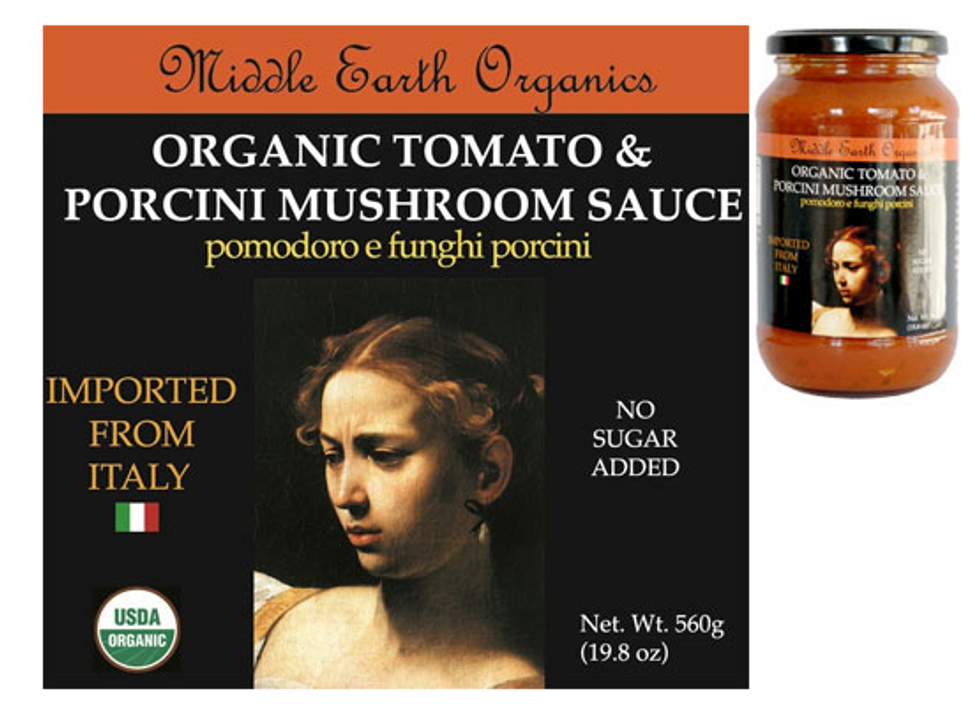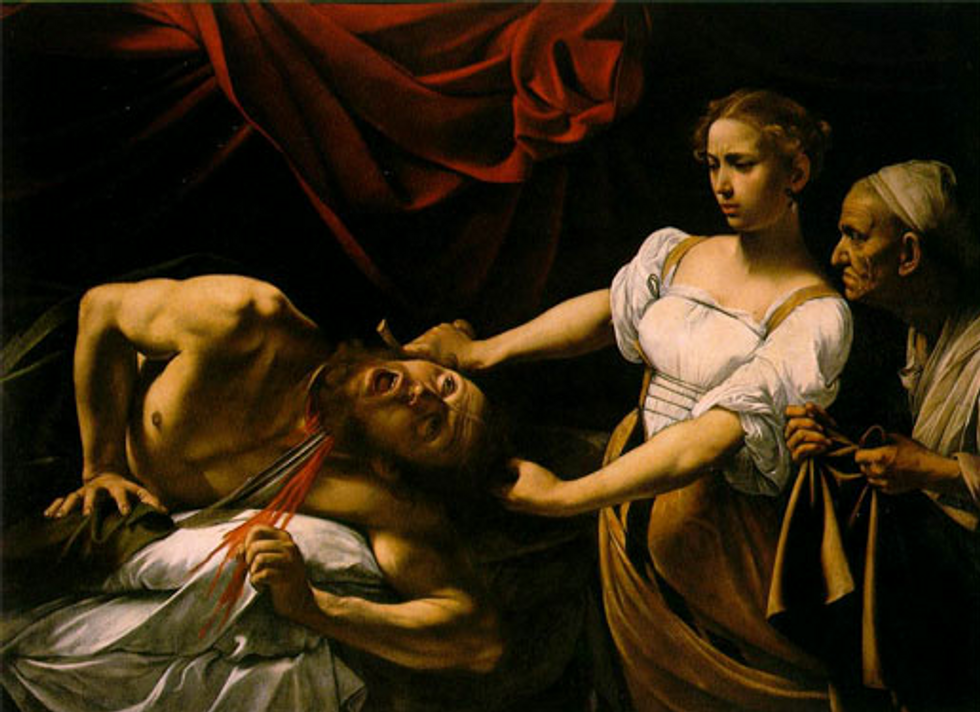The pages of Sandow Birk’s American Qur’an are not adorned with gold filigree or ornate palmettes, as you might find in a more traditional version of the book. Instead, the text is set against rich, colorful paintings depicting everyday life in the U.S.—say, a beach bonfire or a car wash, a wedding or a funeral. Some of his images portray incredibly mundane scenes, like rain falling on an empty parking lot. Others are much more polarizing, like the image of prisoners blinded, muzzled, and handcuffed in a Guantanamo Bay prison yard. The words inscribed on the pages are not Arabic, but English—rendered in a script that emulates the graffiti lettering that marks Los Angeles streets.
This tome looks more like an art project than a holy book—one that took the California-based artist more than nine years to create. Now that Birk has completed illustrating all 114 surahs (chapters of the Qu’ran), his work will finally be released in printed form by W.W. Norton & Co. this September, accompanied by essays from religious scholar Reza Aslan and Yale professor Zareena Grewal.
“A lot of it was about my anger at the war in Iraq,” says Birk, sitting in his Long Beach studio apartment, where he creates much of his work. He shows me one of the Qur’an pages on his computer, one that bears the image of American soldiers in Afghanistan pointing their guns at civilians sitting on the ground.
For almost a decade, Birk has been touring the United States displaying his paintings at galleries and museums. The Southern California surfer first got the idea for American Qur’an while traveling the world for his surf trials, which frequently took him to countries with significant Muslim populations, like Morocco, Indonesia, India, and the Philippines. He had just finished painting a contemporary English-language version of Danté’s The Divine Comedy and was developing a film based on the paintings. “I sort of OD’d on Catholicism,” he says, laughing. “I was getting tired of it.”
At the same time, Birk witnessed the Bush administration’s war on terror unfold across Iraq, Afghanistan, and other places in the Middle East. He became increasingly frustrated with American political discourse, which had turned virulently Islamophobic in the wake of the September 11 attacks and subsequent bombings in London, Moscow and elsewhere in the Western world. “The way people were talking about Islam had nothing to do with the experiences that I had and the people I met or the way I saw them practicing their religion,” Birk says. “So I finally said, I’m sick of hearing people on the radio tell me what Islam is.” He read the Qur’an for himself from cover to cover and began researching historical versions of the holy book online. Immediately, the beauty of these manuscripts struck him, resplendent in intricately inked arabesques and geometric patterns.
Birk’s motivation to start creating his American Qur’an, however, came on a visit to the Chester Beatty Library in Dublin, which houses one of the largest collections of Qur’ans outside the Middle East and North Africa. “The Qur’ans are not as perfect as they look when they’re reproduced,” he says. “When you see them, you see the lines, you see where they erased, where they make a mistake, where they fixed it.” In person, the Qur’ans appeared more like the products of human creativity and art than inaccessible sacred texts. With each new era, the Qur’an’s designs evolved to reflect the style and aesthetics of the time. Birk felt that a project like his was not only feasible, but in line with the tradition of Qur’anic art.
When he got home, he painted about 10 to 15 pages of his own book, using a copyright-free translation written by an English clergyman named John Medows Rodwell in 1861. “Everyone is bummed that I used it, because it’s not very good and it was done by the British colonizers when they were in Egypt,” he says. “It’s biased, and it has little quirky things.” The Rodwell translation is widely regarded by scholars as an Orientalist interpretation of the Qur’an. Birk’s adviser, Grewal, urged him to look at other, more recent translations—by scholars like Muhammad Asad and Thomas Cleary—and incorporate some of those updates into Rodwell’s text.
The images, however, he chose all on his own, deriving inspiration from his L.A. neighborhood and the cities he visited around the country, with the understanding that these sacred texts might be applied to the course of everyday life. “You go to temple, church, mosque, you hear a sermon. How do you take that into your head and become a good person?” says Birk. “So you're thinking about all this stuff, like the afterlife, but you’re going to have to go to the hardware store, and you have to do these mundane things. That’s what real daily life is about.” His depictions are largely quotidian representations of American life here in the U.S. and abroad—images of grocery stores, and local Mexican-American markets, and even of churches and homes illuminated by Christmas lights. In Birk’s America, homeless people push shopping carts overflowing with garbage bags past a brick wall wreathed with razor wire. Middle-aged men costumed in camo clothing aim their rifles at birds circling overhead. Two New Yorkers lie prostrate in prayer on a busy sidewalk.
Other scenes, however, are driven by a more explicitly political intent. For one surah detailing the story of Yusuf, or Joseph, Birk offers a scene in the yard of a California prison. Turn the page, and Mexican immigrants are seen being detained by border police as they attempt to cross over into the United States. “The images I chose were always metaphors,” Birk says, referencing a page about Noah’s ark, illustrated with scenes from New Orleans in the wake of Hurricane Katrina.
“I think that what he’s doing is so brilliant and syncretistic,” says Aslan, a fervent supporter of Birk’s project. He first encountered American Qur’an at a gallery in Pittsburgh. Years later, when W.W. Norton approached him to write the forward for the forthcoming book, Aslan was enthusiastic about participating. “The notion of the Qur’an as a physical object of beauty goes back nearly 1,500 years. So, artistically speaking, Birk is walking in very ancient footsteps, well-trod footsteps.”
And yet, when Birk put up his first show in San Francisco, at the Catharine Clark Gallery, a New York Times article on the project speculated about the possible repercussions he might face for illustrating the Islamic holy book, particularly in light of the Danish cartoon controversy. Birk had just finished his Danté film and was upset by his producers’ insistence on removing his depiction of the prophet Muhammad. Birk wanted to stay loyal to Danté’s vision. “I thought it was wrong to act out of fear,” he told The New York Times at the time. He expressed worry that his new project would incite anger, especially from the Muslim community. But as soon as his American Qur’an show went up, it was clear any fears he—or The New York Times—had were unfounded. Some Muslim leaders, called to comment on the project by journalists looking for worthy soundbites, murmured mild concerns over the implications of a Qur’an qualified by the word “American”—the Qur’an was meant to be universal, with no national or ethnic affiliations. Despite this, Birk’s show produced no considerable dissent from any Muslim groups or individuals. “The only real complaints that anyone got were some angry emails, and they were always from right-wing Christian groups, saying ‘you shouldn’t be reading the Qu’ran,’ or telling people to read it, or showing this work, or ‘take it down,’ ” says Birk.
If there is suspicion about Birk’s project, it’s only because the book, and its visual interpretation of the text, feels unfamiliar to the Qur’anic tradition because of its use of human images rather than abstract designs. A perusal of any historical Qur’an archive will turn up manuscripts embellished in extravagant lapis lazuli fleur-de-lis and bordered by elaborate geometric designs. But unlike the New and Old Testaments, or other religious texts, the Qur’an has only recently become subject to the study of Western literary criticism. “Once these scriptures begin to be viewed not just as sacred and divine but as having literary or artistic merit, regardless of their sacred status, then they can much more easily blend into Western culture, the fabric of Western culture,” says Aslan. “That process with the Quran is very new. The process with the Bible has been going on for about 200 years.” The hegemony of Judeo-Christian texts, too, makes them more conducive to artistic or academic appropriation. The Western art world, in particular, is awash in Judeo-Christian symbology. But the Qur’an is a new addition to this milieu, says Aslan, making Birk’s project a novelty.
“His only agenda is art,” says Aslan. “He is not proselytizing. He is not commenting. He is simply inserting himself as an artist in a thousand-year-old artistic tradition and, like all artists do, adding to that tradition in his own unique way, from his own unique perspective.” Despite Aslan’s insistence, Birk’s own stated intentions—to demonstrate compatibility between an American way of life and Islam—are inherently political.
The images he chooses, too, convey a leftist sensibility, one that is staunchly anti-war and critical of U.S. foreign policy. More than a decade has passed since the inception of the war on terror, but Islam remains an antagonist in the narratives used to justify military and political aggression in the Middle East and North Africa. “When I had the first show of this project, like seven years ago, people would come up and say, ‘Oh, this is so timely! It’s so important that you’re doing this today because of the things happening in the world,’ ” says Birk. “And then several years go by and people are like, ‘This is so timely!’ ” Islam remains culturally relevant to the U.S.—not because it is welcomed here, but exactly because it’s not. Consider this, and the very production of a Qur’an within a culture that wants to destroy it is rendered a political act.
















 TikTok · Bring Back Doors
TikTok · Bring Back Doors 



 Label for Middle Earth Organics' Organic Tomato & Porcini Mushroom Sauce
Label for Middle Earth Organics' Organic Tomato & Porcini Mushroom Sauce "Judith Beheading Holofernes" by Caravaggio (1599)
"Judith Beheading Holofernes" by Caravaggio (1599)